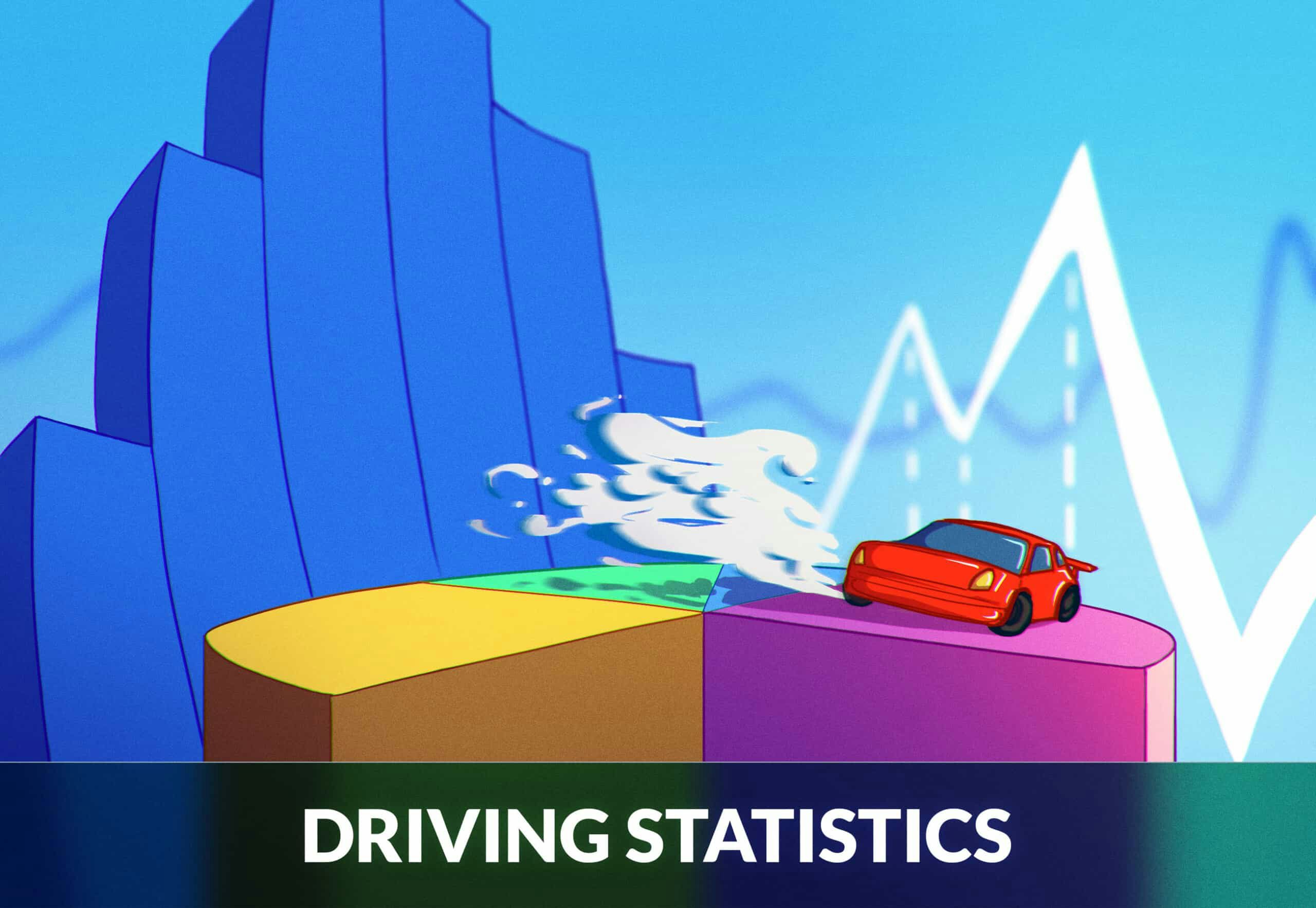
Car Accident Statistics & Facts 2025
Looking for the latest driving statistics in the United States? We’ve gathered all of the most important car accident statistics available in 2022 in one place to make it easily accessible for everyone. The data comes from reputable sources and governmental agencies to ensure accuracy.
The following sources have been used: NHTSA, CDC, IIHS, GHSA, FARS, Statista, US Department of Transportation, Insurance Information Institute (III), Fatality and Injury Reporting System (FIRST), and NSC.
General Driving Statistics
Below, you will find some of the most noteworthy statistics on a general level. We will then go through specific areas more in-depth, such as DUI and speeding.
- 36,096 people lost their lives in motor vehicle crashes in 2019. Another 2.7 million people were injured. (NHTSA, 2019)
- The majority of people killed and injured in traffic crashes were drivers (68%), followed by passengers (24%), motorcyclists (3%), pedestrians (3%), and cyclists (2%). (NHTSA, 2019)
- Fatal crashes decreased by 2.0 percent from 2018 to 2019. (NHTSA)
- The majority of fatal crashes (57%) are single-vehicle accidents, compared to 28% of injury crashes and 27% of property-damage-only crashes. (NHTSA, 2019)
- 0.1% (1 in 1000) of road crashes involve fire. For fatal crashes, the percentage was 3.3%. (NHTSA, 2019)
- Males are more likely to be killed in traffic. The fatality rate as a result of traffic accidents per 100,000 people was lower for females than for males, except for children under 10 years old. (NHTSA, 2019)
- Of the people who were killed in 2019 in traffic crashes, 10,142 (28%) died in alcohol-impaired driving crashes. (NHTSA, 2019)
- 33,244 fatal motor vehicle crashes occurred in 2019. In these crashes, there were 36,096 fatalities. (IIHS, 2019)
- Between 2010 and 2020, there has been a 17.21% increase in road fatalities. The 2020 numbers are still lower than that of 2005, 2000, 1995, 1990, and 1985. (Statista)
- In 2019, it is estimated that 3,142 people died in distraction-related crashes, which is an increase of 10% from the previous year. (GHSA)
- In 2019, 10 142 people died in alcohol-related traffic accidents, which is an average of about one fatality every 50 minutes. (NHTSA)
- Rural areas account for 71% of the Nation’s public road miles and nearly half of the traffic fatalities. (NHTSA)
- 59% of rural traffic fatalities occur within 5 miles of urban areas. (NHTSA)
- While the total number of traffic fatalities increased 11% from 2010 to 2018, fatalities within urban areas increased by 20% (14,988 in 2010 to 17,975 in 2018). (US Department of Transportation)
- 5,014 motorcycle fatalities were reported in 2019. Out of these fatalities, 39% were due to riders not wearing helmets. (FARS)
- 26% (9,478) of the total road fatalities in 2019 were due to speeding. (FARS)
- 5,005 road fatalities involved crashes with large trucks in 2019. (NHTSA)
- 10,420 females are reported to have been killed in road accidents in 2019, which is 28.86% of the total road fatalities. (FIRST)
- From 2009 to 2018 there were 1,207 people (all ages) killed in school-transportation-related crashes — an average of 121 fatalities per year. (NHTSA)
- Almost half of all people killed in road fatalities in 2019 were drivers. More specifically, 17,880 vehicle drivers were reported to have been killed by road accidents in 2019. (FIRST)
- Passengers killed in road crashes accounted for 24.45% (5,807) of the total road fatalities in 2019. (FIRST)
- Pedestrians killed in road crashes accounted for 17.19% of the total road fatalities in 2019. (FIRST)
- 2,740,000 people were injured in 2019 due to motor vehicle crashes. (FARS/CRSS, 2019)
- Out of every 100 million Vehicle Miles Traveled (VMT), the injury rate is about 84. (FARS/CRSS /FHWA)
- There were 1,916,000 crashes that resulted in bodily injury reported in 2019, which accounts for 28.35% of the total crashes that year. (NHTSA, 2019)
- Crashes are more common between 3 p.m. and 5:59 p.m, with 24.53% of all crashes happening between these hours. (FIRST)
- Motor vehicle traffic crashes are the leading cause of death for youth up to 21 years old. (NHTSA – 2019)
- 33,244 fatal crashes were reported in 2019. In 2018, this number was 33,919, and in 2017 it was 34,560. (FARS)
- In 2019, 6,756,000 crashes were reported to the police. This constituted a 4.69% increase from 2017. (FARS/CRSS)
- The road fatality rate per 100 million Vehicle Miles Traveled (VMT) was 1.11. (NHTSA, 2019)
- The fatality rate per 100,000 people ranged from 3.3 in the District of Columbia to 25.4 in Wyoming. (IIHS, 2019)
- The death rate per 100 million miles traveled ranged from 0.51 in Massachusetts to 1.73 in South Carolina. (IIHS, 2019)
Distracted Driving
Is distracted driving actually as bad as everyone says? Well, yes. Just take a look at these statistics.
- In the U.S. in 2018, over 2,800 people were killed and an estimated 400,000 were injured in crashes involving a distracted driver. (CDC)
- About 1 in 5 of the people who died in crashes involving a distracted driver in 2018 were not in vehicles―they were walking, riding their bikes, or otherwise outside a vehicle. (CDC)
- Drivers aged 15 to 19 were the most likely to be distracted in crashes where someone died, with 8% being distracted at the time of the crash. (CDC)
- In 2019, it is estimated that 3,142 people died in distraction-related crashes, which is an increase by 10% from the previous year. (GHSA)
- 9% of all teens who died in motor vehicle crashes were killed in crashes that involved distracted driving. (CDC)
Alcohol and Drugs
Drunk driving plays a major part in the road accidents that occur each day. Although it’s slowly getting better, it’s still far from good.
- In 2019, 10 142 people died in alcohol-related traffic accidents, which is an average of about one fatality every 50 minutes. (NHTSA)
- 39% of motorcycle riders who died in single-vehicle crashes in 2018 were alcohol-impaired. (NHTSA)
- Of the 1,233 traffic deaths among children ages 0 to 14 years in 2016, 214 (17%) involved an alcohol-impaired driver. (CDC)
- The rate of alcohol impairment among drivers involved in fatal crashes was 3.3 times higher at night than during the day (30% versus 9%, respectively). (NHTSA)
- Marijuana use is increasing and it is estimated that 13% of nighttime, weekend drivers have marijuana in their system. (CDC)
- 24% of the young drivers 15 to 20 years old who were killed in crashes had BACs of .01 g/dL or higher – 19% had BACs of .08 g/dL or higher. (NHTSA)
- The 21-24 age group had the highest percentage of alcohol-impaired drivers involved in fatal crashes (at 27%) compared to other age groups in 2019. (US Department of Transportation)
- 4.7% of the U.S. population aged ≥16 years reported driving under the influence of marijuana and 0.9% reported driving under the influence of illicit drugs other than marijuana. (CDC, 2018)
- BAC test results are known for 65% of deceased drivers compared to 24% of surviving drivers in fatal crashes in 2019. (NHTSA)
- The estimated economic cost of all motor vehicle traffic crashes in the US is enormous. In 2010, the cost was $242 billion, of which $44 billion resulted from alcohol-impaired crashes (involving alcohol-impaired drivers or alcohol-impaired nonoccupants). (NHTSA)
- The Federal Bureau of Investigation estimates that 1,024,508 drivers were arrested for driving under the influence of alcohol or narcotics in 2019. This is about one arrest for every 222 licensed drivers in the United States. (III, 2019)
- Among fatally injured passenger vehicle drivers, 32% of males and 21% of females had a BAC at or above 0.08. (IIHS, 2019)
- Drivers under 21 who were killed in crashes had far lower percentages of high BACs at 0.08 or more compared to drivers ages 21-30: 21% versus 42%. (IIHS, 2019)
Pedestrian Accident Statistics
Pedestrians are also at huge risk of being involved in driving accidents. In fact, pedestrian fatalities have steadily been rising the last decade.
- In 2019, pedestrian fatalities accounted for 17% of all road fatalities. In 2010 this percentage was only 13%, and the percentage has been steadily rising each year. (NASS GES 2010–2015 and CRSS 2016, 2019)
- On average, a pedestrian is killed every 85 minutes and injured every 7 minutes in traffic crashes. (NHTSA, 2019)
- In 2019 17% of the children aged 14 and younger that were killed in traffic crashes were pedestrians. (NHTSA)
- Each year, pedestrian injuries account for about 3% of the total traffic injuries. (NHTSA, 2019)
- In 2019 there were 6 205 pedestrians killed in traffic crashes, a 2.7-percent decrease from the 6 374 pedestrians fatalities in 2018. (NHTSA)
- In 2019, there were an estimated 76 000 pedestrians injured in road accidents. (NHTSA)
- A vast majority of all pedestrian fatalities occur in urban areas (82%) compared to rural areas (18%). (NHTSA)
- One out of every five pedestrians killed in road accidents, 20% involved hit-and-run drivers. (NHTSA)
- Seventeen percent of children 14 and younger killed in traffic crashes were pedestrians. (NHTSA, 2019)
- The age group with the highest percentage of pedestrian traffic fatalities is 55-59 year olds at 23%. (NHTSA, 2019)
- The age group with the largest number of pedestrian fatalities in a single year was 55-to-59 year olds at 659 fatalities, followed by 60-to-64 year olds at 550 fatalities and 50-to-54 year olds at 533. (NHTSA, 2019)
- The age group with the smallest number of pedestrian fatalities in a single year was 5-to-9 year olds with 46 fatalities. (NHTSA, 2019)
- The overall male pedestrian injury rate per 100 000 people in 2019 was 26, compared with 21 for females. (NHTSA, 2019)
- The highest overall pedestrian injury rates by age group were for ages 15-to, 20 (33 injuries per 100 000 people), followed by 21-to-24 year olds (31), and 25-to-29 year olds (31). (FIRST)
- It is estimated that the pedestrian had a blood alcohol concentration (BAC) 0.08 or higher in 31 to 33% of all pedestrian road fatalities. (NHTSA, 2019)
- In 2019, pedestrians killed in road crashes in the 21-to-24 age group had the highest percentage of BACs above 0.08 among all age groups (41%). This was followed by 45-54 (40%) and 25-44 (38%). (NHTSA, 2019)
- An estimated 13 percent of fatal pedestrian crashes involved a driver with a BAC of .08 g/dL or higher. (NHTSA, 2019)
- The number of total pedestrian fatalities was highest in California (972), followed by Florida (713) and Texas (649). (NHTSA, 2019)
- New Mexico had the highest pedestrian fatality rate per 100,000 people in 2019, with 3.96, followed by Florida (3.32) and Delaware (3.29). The national fatality rate in 2019 was 1.89. (NHTSA, 2019)
Children Accident Statistics
Learn how children are affected, and to what extent.
- Of the 36,096 traffic fatalities in 2019 in the United States, 1,053 (3%) were children 14 and younger. Among these, 204 (19%) were killed in alcohol-impaired crashes. (NHTSA, 2019)
- Child traffic fatalities stayed roughly the same in 2018 (1 049) and 2019 (1,053). (NHTSA, 2019)
- An estimated 183,000 children were injured in traffic crashes in 2019, a 3-percent decrease from 190,000 in 2018. (NHTSA, 2019)
- On average, 3 children were killed and an estimated 502 children were injured every day in U.S. traffic crashes in 2019. (NHTSA, 2019)
- 67% of children riding in a vehicle with unrestrained adults were also reported to be unrestrained. (NHTSA, 2019)
- Of the 22,215 passenger vehicle occupants killed in traffic crashes in 2019, 731 (3%) were children. Of these, 40% were unrestrained. (NHTSA, 2019)
- Of the 6,205 pedestrian traffic fatalities during 2019, 181 (3%) were children. (NHTSA, 2019)
- Of the 846 pedal cyclist traffic fatalities, 40 (5%) were children. (NHTSA, 2019)
Teen Drivers
How safe are actually teenage drivers on the road? What are the main causes of teenage road fatalities and injuries?
- Teen drivers have crash rates that are nearly 4 times higher than drivers 20 years or older per mile driven. (IIHS)
- Per mile driven, teen drivers aged 16-19 are nearly three times as likely as drivers aged 20 or older to be involved in a fatal crash. (CDC)
- In 2019, 2,375 teenagers (ages 13-19) died in the United States from crash injuries. (IIHS)
- Excessive speed is a factor in just over a quarter of teens’ fatal crashes. (IIHS)
- Between 1996, when the first three-stage graduated driver licensing program was implemented in the United States, and 2019, teenage crash deaths declined by 59 percent (from 5,819 to 2,375). (IIHS)
- For passenger vehicles in 2019, 23% of fatally injured drivers aged 16-19 had positive blood alcohol concentrations (BACs). (IIHS)
- During the intermediate stage, when drivers can drive unsupervised except late at night, crashes were reduced by 9% in the 1st year and 11% in the 2nd year. However, crash rates increased by 4% during the first year after the drivers graduated to full license status. (III)
- In 2019, almost 2,400 teens aged 13–19 were killed as a result of traffic accidents in the US, and about 258,000 were treated in emergency departments for injuries suffered in motor vehicle crashes. (CDC)
- In 2019, about seven teens aged 13–19 died every day due to motor vehicle crashes, and hundreds more were injured. (CDC)
- A Liberty Mutual study found that older teenagers are more likely to engage in dangerous behaviors than the youngest drivers. (Insurance Information Institute)
- A recent survey found that seatbelt usage is lowest in the 16-24-year-old age group. (NHTSA)
- In 2019, the motor vehicle fatality rate for male drivers aged 16–19 was more than two times higher than the fatality rate for female drivers of the same age. (CDC)
- The presence of teen passengers increases the crash risk of unsupervised teen drivers. This risk increases with each additional teen passenger. (CDC)
- In 2019, 40% of motor vehicle crash deaths among teens aged 13–19 occurred between 9 pm – 6 am, and 52% occurred on Friday, Saturday, or Sunday. (CDC)
- Spending is prevalent among teens and young adults. 30% of male drivers aged 15–20 and 18% of female drivers aged 15–20 who were involved in fatal crashes were speeding. (CDC)
- In 2018, 69% of teens aged 15–20 who were killed in motor vehicle crashes after drinking and driving were not wearing a seat belt. (CDC)
Senior Driver Statistics
Are senior drivers safer or more dangerous on the road? Here are the driving statistics that stand out the most.
- In 2018, there were more than 45 million licensed drivers aged 65 and older in the United States. (CDC)
- In 2018, almost 7,700 older adults (aged 65+) were killed in traffic crashes, and more than 250,000 were treated in emergency departments for crash injuries. (CDC)
- For each day in 2018, more than 20 older adults were killed and almost 700 were injured in crashes. (CDC)
- Older drivers, particularly those aged 75+, have higher crash death rates than middle-aged drivers. (CDC)
- The number of Americans ages 65 and older increased by 32% from 2009 to 2018, and crash fatalities in this age group increased by 30% during the same time period. (NHTSA)
- From 2018 to 2019 there was a 3% increase in the number of people 65 and older killed in traffic crashes. (NHTSA, 2019)
- From 2010 to 2019 older male driver (65 or older) fatalities increased by 39%, compared with a 12% increase in older female driver fatalities. (NHTSA, 2019)
- 69% of older pedestrian fatalities in 2019 occurred at non-intersection locations, which is lower than the 84% for those under 65. (NHTSA, 2019)
- In 2019 more people 65 and older were killed on rural roadways than urban (54% and 45%). (NHTSA, 2019)
- The US average for older drivers 65 and older involved in fatal crashes was 15.0% in 2019.
Winter Driving Statistics
Black ice, snowstorms, and other hazardous winter conditions. It sounds dangerous, but just how dangerous is it really?
- Many accidents take place in the rain. In 2019, 198,000 crashes resulting in injury took place in the rain, with 22.27% of these crashes taking place at night on lighted roads. (NHTSA, 2019)
- In 2019, snow/sleet was the reason for 33,000 injury crashes, with about 57.6% of these crashes happening in daylight. (NHTSA, 2019)
- 10.4% and 2.06% of the total injury crashes happen due to rain and snow/sleet respectively. (NHTSA, 2018)
- The most recent figures show that 2,795 people were killed in rainy road conditions during 2019. (FARS 2019 ARF, CRSS 2019)
- In 2019, 1.33% of total road fatalities were due to snow/sleet. (FARS 2019 ARF, CRSS 2019)
Speeding Statistics
Is there any correlation between accidents and speeding? Well, take a look at the statistics.
- The number of speeding-related fatalities decreased by 6% from 2017 to 2018, from 9,947 to 9,378. (NHTSA, 2018)
- 30% of male drivers among 15, 20 year olds and 18% of female drivers in the same age group involved in fatal crashes were speeding. This is the highest percentage among any of the age groups. (NHTSA, 2018)
- Among speeding drivers involved in fatal crashes in 2018, 25% did not have valid driver licenses at the time of the crashes, compared to 12% of non-speeding drivers. (NHTSA, 2018)
- There is a correlation between speeding and drinking. Drivers who were speeding when involved in fatal crashes in 2018 were more likely to have been drinking (37% versus 16%) than those drivers who were not speeding. (NHTSA)
- 31% of motorcycle riders involved in fatal crashes were speeding, which is more than drivers of any other vehicle type. (NHTSA)
- Among fatal crashes, nearly half (48%) of speeding drivers were unrestrained at the time of crashes, compared to 21% among non-speeding drivers. (NHTSA, 2018)
- Among the passenger vehicle drivers who were speeding, California had the lowest percentage of unrestrained drivers (23%) and South Dakota had the highest percentage (79%). (FARS 2018)
- In every state, speeding drivers involved in fatal crashes were more likely to be impaired by alcohol compared to non-speeding drivers. (NHTSA, 2019)
- 8.8% (2,527) vehicle occupants were killed at a speed of 30 mph or less in 2019. (NHTSA, 2019)
- 15.7% (4,502) of vehicle occupants were killed at a speed of 30-40 mph. (NHTSA, 2019)
- 19.1% (5,493) of vehicle occupants were killed at a speed of 40-50 mph. (NHTSA, 2019)
- 28.2% (8,121) vehicle occupants were killed at a speed of 50-60 mph. (NHTSA, 2019)
- 23.3% (6,853) of vehicle occupants were killed at a speed of 60 mph or higher. (NHTSA, 2019)
- At 55 mph, 76.2% (6,192) of the fatalities occurred in rural areas and 23.7% (1,922) in urban areas. (FARS 2019 ARF)
Drowsy Driving Statistics
It’s never good to drive when you’re feeling drowsy. Here’s why.
- Between 2013 and 2017 there were 4,111 fatalities that involved drowsy driving. (III)
- In 2017, there were 91,000 police-reported crashes that involved drowsy drivers with about 50,000 people being injured. (III)
- The number of fatalities involving a drowsy driver in 2019 was 697 (equal to 1.9% of total fatalities). This represents an 11.2% decrease from 785 fatalities in 2018. (NHTSA)
- Drowsy driving affects everyone, but especially those under age 25, who make up an estimated 50% or more of drowsy driving crashes. (NSC)
- Drowsiness was involved in an estimated 1.4% of all police-reported crashes nationwide, 2% of crashes that resulted in injuries, and 2.4% of crashes that resulted in a death between 2011 and 2015. (III)
- The estimated 2016 annual societal cost of fatigue-related fatal and injury crashes was $109 billion. (GHSA)
Traffic Fatalities by Location
Are there any states that stand out in the data? Let’s see.
- Alaska had the highest percentage of deaths involving SUV and pickup occupants (48%) and a relatively low percentage of deaths involving car occupants (24%). (IIHS, 2019)
- Vermont had the highest percentage of deaths involving car occupants (45%) and a relatively low percentage of deaths involving SUV and pickup occupants (21%). (IIHS, 2019)
- Hawaii reported relatively low proportions of fatalities for both cars (19%) and SUVs & pickups (23%), but a high percentage of pedestrian deaths (33%). (IIHS, 2019)
- The District of Columbia had the highest percentage of fatalities involving pedestrians (39%) out of all US states. (US Department of Transportation)
- Delaware, Florida and New York tied for the highest percentage of traffic fatalities involving cyclists (5%). (NHTSA, 2019)
- Maine had the highest percentage of deaths in single-vehicle crashes (68%), while Nebraska had the highest percentage of deaths in multiple-vehicle crashes (57%). (US Department of Transportation)
- Delaware had the highest restraint use percentage among fatally injured occupants (61%). (IIHS, 2019)
- Massachusetts had the lowest restraint use among fatally injured occupants at just 30%. (IIHS, 2019)
- 45% of motor vehicle crash deaths in 2019 occurred in rural areas. (IIHS, 2019)
- The states with the highest percentage of traffic fatalities on rural roads were Vermont (89%), Montana (86%), and Wyoming (84%). (IIHS, 2019)

550+ exam-like questions
All you need to ace your test
Perfect for first-timers, renewals and senior citizens
Recommended articles
Ace your DMV test, guaranteed
Want to Be the Top School in Your Area?
- Simple & automated admin
- More time for teaching
- #1 learning materials for students


